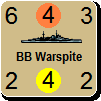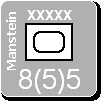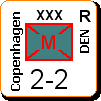warspite1
Posts: 41353
Joined: 2/2/2008
From: England
Status: offline

|
Having taken a bit of R+R after completing the named German surface units, I have now made a start on finalising the Royal Australian Navy units. The first of these is the light cruiser Perth.
[4006 Perth - by Robert Jenkins]
.B Engine Output: 72,000 hp
.B Top Speed: 32.5 Knots
.B Main armament: 8 x 6-inch (152mm), 4 x 4-inch (102mm) guns
.B Displacement (full load): 9,150 tons
.B Thickest armour: 3-inch (belt)
.P The Amphions were a sub-class of the Leander-class light cruisers, although
some sources state they were a separate class. The main difference between the
two types was the layout of the boiler and engine rooms, resulting in the earlier
Leanders having just one funnel, while the Amphions had two.
.P All three ships that made up this sub-class were ultimately transferred to the
Royal Australian Navy (RAN). In Royal Navy (RN) service they were named after
Roman or Greek mythological characters, but their names were changed upon
transfer to the RAN and they were re-named after major Australian cities.
.P The treaty that followed the London Naval Conference of 1930 allowed Britain
to build 91,000 tons of cruisers up to the end of 1936. The original plan was to
build fourteen Leander-class at 6,500 tons each. However the class ended up
heavier than planned, resulting in a reduced number of this type being built. The
first ship completed was significantly over-weight and subsequent ships had their
weight pared back. As a result, the Amphions were lighter than the Leanders.
.P As was by then standard for the RN, the class were fitted with a six-inch main
armament, backed up by four, high-angle, four-inch secondary guns that provided
the main anti-aircraft (AA) defence.
.P The design proved very rugged and capable of withstanding severe punishment,
although the Amphions proved unluckier than the Leanders; two of the three ships
were sunk early in the war.
.P HMAS Perth was completed in July 1936 as HMS Amphion. In Greek mythology,
Amphion was one of the twin sons of Zeus. Upon transfer to the RAN, she was named
after the capital of Western Australia. She was originally crewed by the officers
and men from the old First World War vintage cruiser Adelaide, who had sailed to
the UK in May to man the ship.
.P Perth was commissioned into the RAN in June 1939, just three months before the
German invasion of Poland, and she was in the West Indies in August, on her way
to Australia, when the RN was placed on a war footing. As a result, she began the
Second World War deployed in the West Indies, where she took part in searches for
enemy blockade-runners.
.P At the start of October, she was part of the Atlantic escort for the large
forty-five ship convoy KJ3 to the UK, during which she received weather damage.
She returned to Bermuda and after completion of the repair work, was sent to the
Pacific briefly, where she was deployed with two Canadian destroyers. Perth
returned to the West Indies at the end of 1939 and remained in the Caribbean
until the end of February, when she was released from duty in the West Indies and
sailed through the Panama Canal for Australia.
.P Perth reached Sydney on the 31st March 1940 and was initially deployed for
trade protection duty off the east coast of Australia. She took part in the
search for the German auxiliary cruisers Orion in May and Pinguin in November,
each time without success.
.P With Italy having entered the war the previous June, and the naval war in the
Mediterranean beginning to escalate, Perth was sent to reinforce the RN there and
she sailed for Alexandria, Egypt, in December; escorting convoy US7 on the way.
At the start of the following year, she was deployed in Force D in the Aegean
with fellow cruisers Orion and York as part of the multi-purpose Operation Excess
(see HMS Southampton). Perth was lightly damaged during an air attack at the end
of the operation, but safely returned to Alexandria on the 18th.
.P Following Excess, Perth had repair work carried out and she also received
additional close-range AA weaponry at this time. In February, she was deployed in
the eastern Mediterranean for the ill-fated Operation Abstention, in which the
British tried to gain a foothold in the Dodecanese island chain (see HMS
Bonaventure).
.P In March, Perth covered the Lustre convoys that took an expeditionary force to
Greece, escorted convoy MW6 to Malta (see HMS Bonaventure) and took part in the
successful Battle of Cape Matapan (see HMS Barham). The following month, she
took part in covering two convoy operations (see HMS Ajax) that included a
shore bombardment mission against Tripoli and was then called upon to assist the
evacuation of the expeditionary force from Greece after the Germans intervened
there, to devastating effect (see Transport Counter 4725).
.P At the start of May, Perth took part in a complex operation that involved the
sailing of the famous Tiger convoy through the Mediterranean to Egypt (see
Transport Counter 4729) and two convoys being sent to Malta from Alexandria. The
Mediterranean Fleet covered the latter two convoys and then the Tiger convoy once
it had passed Malta. Later that month, Perth was sent to operate off Crete, where
she was tasked with intercepting enemy shipping seeking to land reinforcements
for the paratroopers that had previously landed on the island (see HMS Fiji). She
was hit by a bomb during this operation that damaged her bridge and she returned
to Alexandria for repairs. She was quickly patched up and returned to Crete to
assist the evacuation operation.
.P Despite the German invaders facing a number of obstacles, including the
problems of re-supply and the good defensive terrain, the paratroopers managed to
push the Commonwealth forces back until eventually, an evacuation was the only
avenue open to them. Once again, just as in Norway, France and Greece, the RN
were tasked with the job of saving the Army in the face of overwhelming enemy air
superiority. The operation would prove costly but Admiral Cunningham refused to
allow the Navy to let the Army down. When asked about the cost of the operation,
Cunningham famously said, “It takes three years to build a ship; it takes three
centuries to build a tradition”. Thanks to the RN, over the period of four nights
from the 28th May, 16,000 of the 22,000 troops on Crete were evacuated from
Sphakia and Heraklion. The cost to the Navy had been high, losing three cruisers
and six destroyers in the process. Heavily involved in those last few days were
the cruisers: Ajax, Calcutta, Coventry, Dido, Orion, Perth and Phoebe, the
cruiser minelayer Abdiel and the destroyers Hereward, Hotspur, Imperial, Jackal,
Kimberley and Napier. On the 31st May, Perth was damaged during an air attack and
she required a further period of repair.
.P In June and early July, Perth took part in RN operations to support the
fighting against the Vichy regime in Syria (see HMS Phoebe). This was to be the
last Mediterranean operation for the cruiser, and in mid-July, she was ordered to
return to Australia. She arrived a month later and was taken for a refit, which
lasted until December. She was ready in time to meet the new threat from Japan,
following their attack on Pearl Harbor on the 7th December 1941.
.P She was initially deployed as part of the ANZAC Squadron and along with the
heavy cruisers Australia and Canberra and her "half" sister HMNZS Achilles, she
escorted US troop convoys to New Caledonia and New Guinea during that month.
Then, in the New Year 1942, with Allied forces being pushed back in the
Philippines and Malaya, ABDA - American, British, Dutch, Australian - command was
set-up to pool the few assets available to the Allies, and to try and contain the
Japanese. Perth became part of the naval force, under the overall command of the
American Admiral Hart. Her initial role within ABDA remained convoy defence in
Australian waters, but this changed at the end of January as the crises in Malaya
and then Singapore began to unfold.
.P On the 24th February, Perth arrived at Tanjong Priok, western Java along with
the heavy cruiser Exeter and three destroyers. From there, the ships were sent to
join the Eastern Striking Force at Soerbaya, on Java`s north-east coast. There,
she was part of a force containing the Dutch light cruisers De Ruyter (Flagship
of Admiral Doorman) and Java, the US heavy cruiser Houston, Exeter and nine US,
British and Dutch destroyers. Notably absent from the Allied order of battle was
air cover, as it had been for most of the campaign; this lack of air cover was to
have dire consequences for the Allied ships.
.P The force sailed on the night of the 26th in order to try and locate an
invasion convoy, although they returned the following morning having found no
sign of the enemy. No sooner had they arrived back in port, than a new sighting
was reported, and Admiral Doorman put to sea once more. This time the Allied
force found the Japanese and what became known as the Battle of the Java Sea was
fought (see HMS Exeter). The battle was a disaster for ABDA, losing the two Dutch
cruisers, along with Doorman, and two British and one Dutch destroyer.
.P Perth and Houston retreated back to Tanjong Priok and arrived there in the
early afternoon of the 28th. Later that day, at 1900hrs, the two cruisers were
ordered to sea for what would be their final time. Short of both ammunition and
fuel, they were to head for Tjilatjap, southern Java. There were no destroyers in
working order available to escort them, although the Dutch destroyer Evertsen did
get underway after the cruisers had left and sailed some way behind them. This
lack of destroyer escort would prove crucial to the events about to unfold. With
Perth`s Captain Waller senior to the US Captain Rooks, Perth was the command ship
as they began their journey west, sailing toward the Sunda Strait, that separated
the islands of Java and Sumatra.
.P However, at 2200hrs, at the entrance to the Strait, they came across an
invasion convoy that was taking Japanese troops to land in Western Java. The
convoy was defended by a light carrier and numerous cruisers and destroyers,
although for close escort the convoy could call on only the light cruiser Natori
and eight destroyers. The fifty-ship invasion convoy presented Waller and Rooks
with a most unexpected, but highly important target.
.P What became the Battle of the Sunda Strait began just after 1100hrs, when the
cruisers opened fire on the Japanese destroyer Harukaze. They were then subjected
to a torpedo attack launched from Fubuki, but the torpedoes were avoided. The
Natori arrived with five destroyers shortly afterwards, and a fire fight broke
out. The Allied cruisers found their targets, damaging two of the Japanese
destroyers, and the enemy ships had to make smoke and withdraw. At around 1120hrs
the heavy cruisers Mikuma and Mogami arrived to assist the lighter forces and
this enabled the destroyers to get in close for torpedo attacks. Perth and
Houston were running out of ammunition but bravely fought on, giving at least as
good as they got. However, sheer weight of numbers told in the end and there were
simply too many enemy to keep at bay. The Japanese launched wave after wave of
torpedoes from both their destroyers and their cruisers and at 0025hrs on the 1st
March, Perth, having been hit by four of these, sank. She was joined shortly
afterwards by Houston. The damage to the convoy came courtesy of friendly fire
and not from the Allied ships. No less than four transports were sunk by Japanese
torpedoes, one of which contained the commander of the Japanese land forces,
Lt-General Imamura, though he survived the sinking. The Evertsen, that was
sailing to catch-up with Perth and Houston, stumbled across the Japanese shortly
afterwards and was beached after receiving numerous shell hits.
.P Over 1,000 officers and men from the two cruisers perished, of which 375 were
from Perth. Many of the survivors were later to die at the hands of the Japanese
whilst prisoners of war.
< Message edited by warspite1 -- 9/20/2009 8:55:37 AM >
_____________________________
England expects that every man will do his duty. Horatio Nelson October 1805  |
 Printable Version
Printable Version










 . Please see below for the write-up of the Tirpitz. It`s funny how you can get attached to some of these ships - I actually felt sorry for the "Lonely Queen" while learning about her
. Please see below for the write-up of the Tirpitz. It`s funny how you can get attached to some of these ships - I actually felt sorry for the "Lonely Queen" while learning about her 
 ), HFJ has Scharnhorst, does anyone have any favourite ships of WWII?
), HFJ has Scharnhorst, does anyone have any favourite ships of WWII?  . From looking at this picture - I would say the aircraft must have required some form of assembly. Are Thirty two fighters going to fit on her? I have no idea if the P-40 had folded wings, if they did that may be possible but I very much doubt it.
. From looking at this picture - I would say the aircraft must have required some form of assembly. Are Thirty two fighters going to fit on her? I have no idea if the P-40 had folded wings, if they did that may be possible but I very much doubt it. 


 New Messages
New Messages No New Messages
No New Messages Hot Topic w/ New Messages
Hot Topic w/ New Messages Hot Topic w/o New Messages
Hot Topic w/o New Messages Locked w/ New Messages
Locked w/ New Messages Locked w/o New Messages
Locked w/o New Messages Post New Thread
Post New Thread